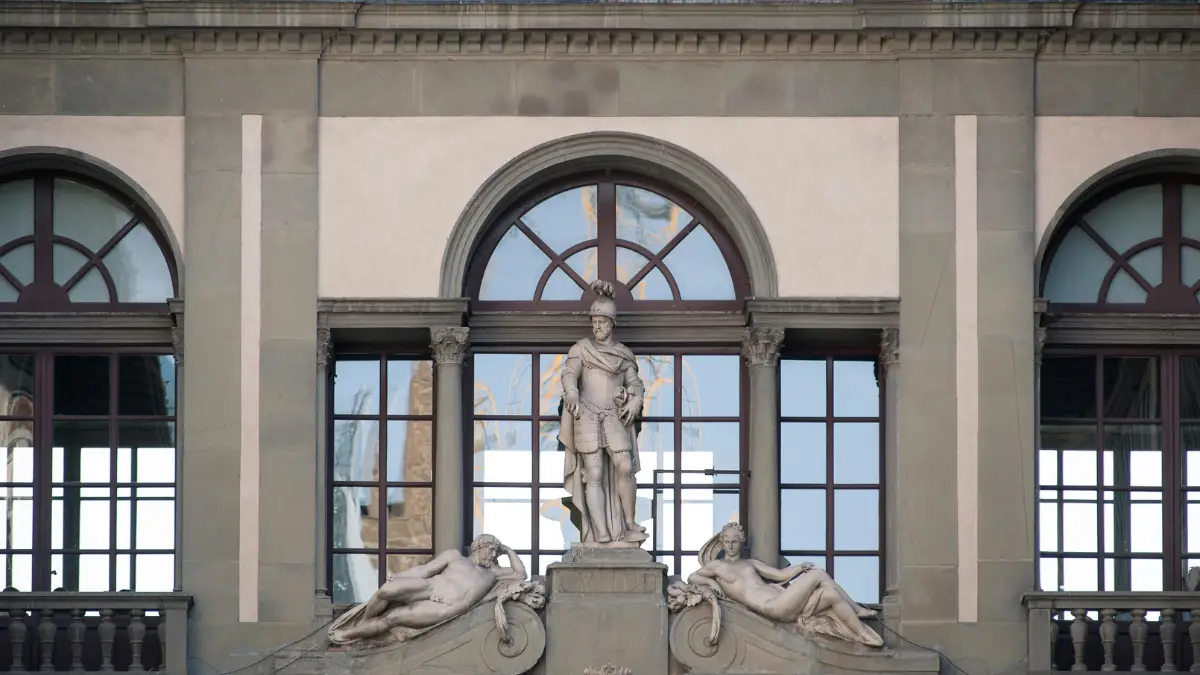Uffizi Gallery
Are you an art lover or a history enthusiast? Do you admire Renaissance masterpieces or dream of walking through grand galleries? The Uffizi Gallery, one of the most renowned art museums in Florence, invites you on a cultural journey through centuries of artistic brilliance.
Top Uffizi Gallery Tickets and Tours
Entry ticket to the Uffizi Gallery
From
€24
- Skip the long lines and walk straight into the Uffizi Gallery
- Ideal for independent travelers who want flexibility and prefer exploring at their own pace
- Includes a reserved entry ticket to view Renaissance masterpieces like Botticelli’s The Birth of Venus
- A host who ensures a smooth check-in and provides essential tips before you begin your self-guided visit
Guided tour of the Uffizi Gallery
From
€69
- Join a small group for a guided experience of Florence’s most iconic gallery
- Get expert insights into major artworks by Michelangelo, Leonardo da Vinci, and Botticelli
- Perfect for those who want to understand the deeper stories behind the art
Small group tour of the Uffizi Gallery
From
€71
- Avoid queues and explore the Uffizi in a group led by a professional art historian
- Enjoy an immersive 2-hour tour covering all the highlights of the museum
- Includes skip-the-line access and personalized attention in a small group setting
Uffizi and Accademia Gallery tour
From
€125
- Combine Florence’s top two art galleries in one expertly guided tour
- Admire Michelangelo’s David at Accademia and Renaissance gems at the Uffizi
- Ideal for art enthusiasts seeking a comprehensive cultural experience
Uffizi, Pitti & Boboli 5-day combined ticket
From
€59
- Access three must-see Florentine attractions with one ticket
- Wander the grand halls of the Uffizi, discover royal apartments at Pitti Palace, and relax in the Boboli Gardens
- Perfect for those looking to explore beyond just the Uffizi
Florence Pass
From
€93
- A 3-in-1 digital city pass covering the Uffizi Gallery, Accademia Gallery & Brunelleschi’s Dome
- Includes skip-the-line tickets, audio guide app, and a downloadable Florence city guide
- Best for travelers who want to experience Florence’s highlights with one convenient booking
History of the Uffizi Gallery
The Uffizi Gallery, one of the world’s most renowned art museums, was originally built in 1560 by order of Cosimo I de’ Medici to serve as government offices, or “uffizi.”
Designed by Giorgio Vasari, the structure was later expanded by architects Buontalenti and Parigi.
In 1581, Cosimo’s son, Francesco I, transformed the top floor into a private gallery for the Medici family’s growing art collection.
Thanks to a 1743 Family Pact by Anna Maria Luisa de’ Medici, the artworks remained in Florence and were opened to the public in 1769.
Today, the gallery continues to evolve under the “Nuovi Uffizi” project.
Things to Know Before You Book
Ready to plan your visit? Here’s what you should keep in mind before booking your Uffizi Gallery tickets.
- All standard tickets come with a specific time slot. Arriving late could mean losing your entry, so be sure to get there a few minutes early.
- An audio guide is perfect for exploring at your own pace while uncovering the stories behind the art. Guided tours, on the other hand, offer in-depth commentary and expert-led insights that enrich your experience.
- With fewer participants (usually no more than nine), small group tours allow more interaction, questions, and a deeper connection with masterpieces like Botticelli’s The Birth of Venus and Michelangelo’s Doni Tondo.
- Pair your gallery visit with access to the Pitti Palace and Boboli Gardens. Together, they tell the full story of Medici power, art, and lifestyle—indoors and out.
- Some tours include a visit to the Vasari Corridor, the secret elevated walkway once used by the Medici. After your timed entry to the Uffizi, you’ll join the corridor tour two hours later in Room D19 on the first floor.
- Skip-the-line combo tickets for the Uffizi and Accademia Gallery are great for art lovers looking to admire both Botticelli and Michelangelo in one day.
- Kids under 18 enter free when accompanied by an adult, though there’s a €4 reservation fee for advance bookings. Entry is also free for all visitors on the first Sunday of every month—but be prepared for large crowds.
Plan Your Visit to Uffizi Gallery
The Uffizi Gallery in Florence is open from Tuesday to Sunday throughout the year.
Opening hours are from 8.15 am to 6.30 pm, with last entry at 5.30 pm.
The museum remains closed every Monday, as well as on January 1 and December 25.
Free entry is offered on the first Sunday of each month, and on April 25, June 2, and November 4 (partial access).
For fewer crowds, visit before 10 am or after 4 pm on weekdays, especially Wednesday or Thursday.
Address: Piazzale degli Uffizi, 6, 50122 Firenze FI, Italy. Get Directions
From Florence Airport: Volainbus shuttle to SMN Station, T2 tram to SMN Station
By Train: Nearest station: Firenze Santa Maria Novella (SMN)
Walk: 15–20 minutes via Duomo and Piazza della Signoria
Bus/Tram: C1 bus or T1 tram with transfer
By Bus: C1, C2, 23
Nearest stops: Lungarno Archibusieri, Galleria degli Uffizi, Borgo dei Greci
By Car: Parking near the gallery is the toughest to find due to ZTL restrictions. Use garages outside the zone.
Suggested parking: SMN Station Garage, Parcheggio Park Matteotti
The Uffizi Gallery has three main entrances around Piazza degli Uffizi, each serving different visitor types for efficient entry.
Door 1 – For groups, school tours, Firenze Card holders
Door 2 – For same-day ticket purchases
Door 3 – For online bookings and skip-the-line tickets
Wheelchair Access: Available at all entrances with staff assistance.
The best time to visit the Uffizi Gallery is right at opening (8:15 am) or late afternoon around 4 pm to avoid crowds.
The best days to visit the Uffizi Gallery are Wednesdays and Thursdays. Avoid Tuesdays and weekends due to higher footfall.
The best time of the year to visit the Uffizi Gallery is from November to March, especially midweek, for fewer crowds and lower prices.
Most famous Artworks
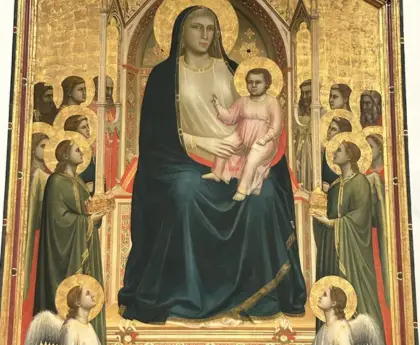
Giotto’s Madonna and Child Enthroned with Angels and Saints shows Mary holding baby Jesus, surrounded by angels and saints. It marks a shift toward more natural, lifelike religious art.
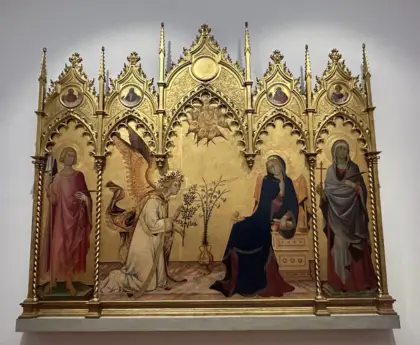
This painting by Simone Martini and Lippo Memmi shows the angel Gabriel telling Mary she will have Jesus. St. Maxima and St. Ansanus stand beside, adding to the scene’s beauty and grace.
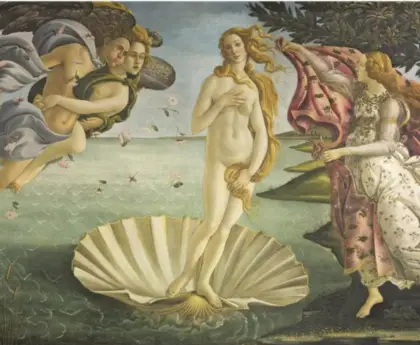
In The Birth of Venus, Botticelli shows the goddess Venus arriving on a seashell, blown to shore by the wind gods. The painting feels full of motion, beauty, and gentle sea breeze.
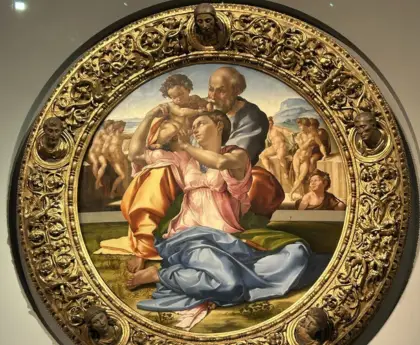
Michelangelo’s Doni Tondo shows the Holy Family in a round frame. The colors are bright, the figures strong, and the scene full of life—showing his skill in both painting and sculpture.
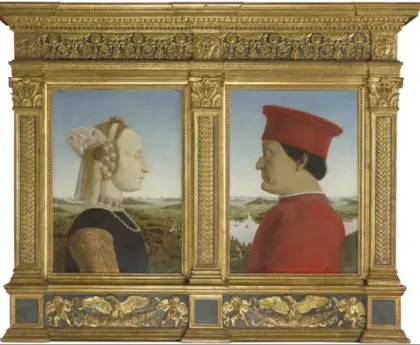
Piero della Francesca’s portraits of Duke Federico and Duchess Battista show them in profile, highlighting their power and elegance. The background shows their land, symbolizing wealth and rule.
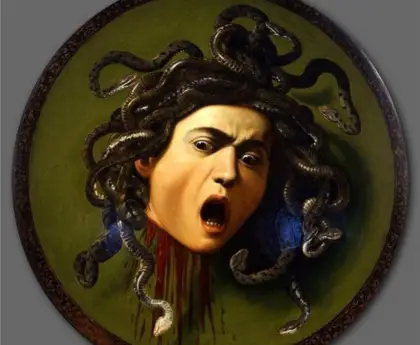
Caravaggio’s Head of Medusa shows the exact moment Medusa is beheaded. Her face is frozen in shock and pain, with snakes writhing around her head—painted on a real shield for dramatic effect.
Collections at the Uffizi Gallery
The Uffizi Gallery houses one of the world’s finest collections of Renaissance art.
Visitors can see iconic works by Botticelli, Michelangelo, Leonardo da Vinci, and Caravaggio.
Masterpieces like The Birth of Venus, Annunciation, and Medusa reflect centuries of artistic brilliance.
Each painting tells a story—of mythology, religion, and the evolution of human.
The Uffizi Gallery isn’t just about paintings—it also showcases remarkable sculptures.
Statues of famous Italians like Dante, Michelangelo, and Galileo adorn the outdoor niches.
Inside, you’ll find ancient Roman busts, mythological figures, and Renaissance marble works.
These sculptures add depth to the Uffizi’s celebration of Italian art and culture.
Designed by Giorgio Vasari in 1560 as offices (uffizi) for Florence’s magistrates.
The grand staircases at the entrance were added in the 19th century.
The Tribune is an octagonal room meant to display masterpieces.
Long corridors connect rooms filled with ancient sculptures and art.
The “Primitive” Rooms show early Tuscan art.
The Niobe Room features classical sculptures.
The Uffizi Library preserves rare art texts.
Found on the first floor in a former 16th-century Medici theatre.
Restored in the 1950s by architect Edoardo Detti.
Includes a modern Study Room with 30+ research stations.
Houses over 177,000 drawings and prints, mainly from the Renaissance and 17th-century Tuscany.
The collection began with Cardinal Leopoldo de’ Medici.
Offers a photo archive, specialist library, and expert restoration lab
Beyond the Uffizi Gallery
Vasari Corridor
The Vasari Corridor, reopened in December 2024, is a 750-meter elevated passage built by Vasari in 1565 for the Medici. It links the Uffizi to Pitti Palace via Ponte Vecchio. Entry requires a special, non-refundable ticket and must be booked in advance. Access is only through the Uffizi, with specific timings and rules. An extra fee applies for pass holders.
Pitti Palace
Pitti Palace, once home to the Medici, Habsburg-Lorraine, and Savoy families, now houses five museums showcasing art, fashion, and royal treasures. Located beyond the Arno, it’s open Tue–Sun, 8.15 am–6.30 pm. Facilities include lifts, a cloakroom, audioguides, a bookshop, and a café.
Boboli Gardens
Boboli Gardens, behind Pitti Palace, were created by the Medici in the Italian garden style and expanded by later dynasties. This vast open-air museum features statues, grottos like Buontalenti’s, and grand fountains such as Neptune’s. Open year-round with seasonal hours, the gardens are mainly sloped and best explored with assistance due to uneven terrain.
Accademia Gallery
The Accademia Gallery in Florence is best known for Michelangelo’s sculptures, including the iconic David, Prisoners, and St. Matthew. It also features works by Botticelli, Ghirlandaio, Pontormo, and more. The museum holds Medici-commissioned paintings and rare musical instruments by Stradivari and Cristofori, celebrating Florence’s rich artistic heritage.
Frequently asked questions about the Uffizi Gallery
Here are some frequently asked questions about the Uffizi gallery.
Can I skip the line at the Uffizi Gallery?
Yes, skip-the-line tickets are available and highly recommended, especially during peak hours when wait times can exceed two hours.
Are there discounts or free entry options at the Uffizi Gallery?
Yes, EU citizens under 18, school groups, and other eligible visitors receive free entry (a €4 reservation fee still applies). Free entry days are occasionally offered.
Do I need to book tickets in advance?
Yes, you need to book your tickets in advance, especially on weekends and holidays. Reservations must be made at least one day before your visit to guarantee entry.
What are the Uffizi Gallery’s opening hours?
The gallery is open Tuesday to Sunday from 8.15 am to 6.30 pm. It is closed on Mondays, January 1, and December 25.
Where is the Uffizi Gallery located, and how do I get there?
Located at Piazzale degli Uffizi 6, Florence, it’s about a 20-minute walk from Santa Maria Novella train station. The nearest bus stop is Diaz, 250 meters away. Get Directions
How long does a visit to the Uffizi Gallery take?
A complete visit typically takes 3–4 hours. If short on time, the main highlights can be seen in about 2 hours.
When is the best time to visit to avoid crowds?
Crowds are lighter after lunch (1–3 pm) or closer to closing time. November to February is considered the off-season.
Is the Uffizi Gallery accessible for people with reduced mobility?
Yes, ramps, elevators, and wheelchairs are available, although lifts in the east wing are not accessible.
Are guided tours or audio guides available?
Audio guides can be rented onsite for €6 in multiple languages. Private tours are available through external providers.
Can I take photos inside the Uffizi Gallery?
Yes, personal photography is allowed without flash, tripods, or selfie sticks. Commercial use requires special permission.
What visitor rules should I follow at the Uffizi Gallery?
Keep phones silent, speak quietly, wear appropriate clothing, and don’t touch the art. Food, large bags, and pets (except guide dogs) are prohibited.


